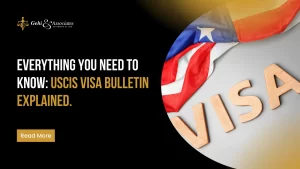 When most people hear the term “USCIS Visa Bulletin Queens immigration,” they often think of a confusing chart. One that is filled with numbers and dates that don’t make much sense. However, this monthly publication is critical for anyone waiting on a family-based or employment-based green card. It determines who can move forward, when they can file, and how long their journey to permanent residency may take. Unfortunately, for many immigrants in Queens and across the U.S., the Visa Bulletin feels more like a riddle than a roadmap.
When most people hear the term “USCIS Visa Bulletin Queens immigration,” they often think of a confusing chart. One that is filled with numbers and dates that don’t make much sense. However, this monthly publication is critical for anyone waiting on a family-based or employment-based green card. It determines who can move forward, when they can file, and how long their journey to permanent residency may take. Unfortunately, for many immigrants in Queens and across the U.S., the Visa Bulletin feels more like a riddle than a roadmap.
Thousands of families and employers anxiously refresh the Department of State’s website every month. Checking to see whether their “priority date” has finally become current. A single update can mean waiting years or finally moving forward with your green card application. In Queens families from India, Mexico, the Philippines, and beyond, check those cut-off dates with hope, frustration, or sometimes despair.
Understanding the Visa Bulletin means understanding your place in a line that millions of people are standing in. This line is shaped by country quotas, preference categories, and shifting government demand. At Queens Immigration Attorney, we provide local insights tailored to the Queens immigrant community. We highlight practical checklists and common pitfalls. Our experienced immigration attorneys won’t just “read” the Visa Bulletin; they understand it and use it to help your case.
Key Insights:
- The Visa Bulletin segregates visa availability by family-based and employment-based categories
- The USCIS Visa Bulletin is published monthly by the U.S. Department of State
- The Visa Bulletin visually tracks visa number usage and availability.
- The number of green cards issued in oversubscribed categories depends on the Visa Bulletin’s cutoff dates. Which are aligned with the annual limits on visas per country and preference
- For employment-based visas, the Visa Bulletin distinguishes multiple preference categories
- The Visa Bulletin also incorporates spillover visas from family-based categories into employment-based categories to optimize visa use.
How to Read the USCIS Visa Bulletin: Step-by-Step
Many Queens residents rely on the USCIS visa bulletin Queens immigration updates to stay ahead of sudden changes. The Visa Bulletin can look intimidating at first glance. Let’s break it into manageable steps. This way, you can learn how to find your priority date and confirm your category.
What is the USCIS visa bulletin?
The Visa Bulletin is a monthly release from the U.S. Department of State. It tells applicants whether their green card cases are eligible to move forward. USCIS then confirms which of the two charts you should follow for filing that month. For those tackling the process in Queens, understanding the USCIS visa bulletin Queens immigration is the first step toward clarity.
- It signals who can file and who must wait.
- It separates family-based and employment-based categories clearly.
A Queens immigration attorney can explain how the bulletin impacts your individual timeline and prevent mistakes with chart selection.
How to find your priority date
Your priority date is essentially your spot in line. Family-based applicants get this date when USCIS receives Form I-130. However, employment-based applicants often receive it with a PERM or I-140 filing. This date appears on your I-797 receipt notice and becomes critical each time the bulletin updates.
- Always keep your priority date accessible.
- Compare it carefully against the monthly cut-off dates.
An experienced immigration attorney can help you never miss a filing window by helping you track this date.
How to determine your preference category
Immigrant visas are divided into preference categories, each with unique rules. Family petitions are grouped into F1, F2A, F2B, F3, and F4. Employment petitions are grouped into EB-1 through EB-5, each tied to skills, education, or investment. The USCIS visa bulletin Queens immigration highlights how these categories directly shape wait times.
- Family categories prioritize immediate relatives and unmarried children.
- Employment categories prioritize high-demand skills and certain workers.
How to read the Visa Bulletin chart
The chart uses rows for categories and columns for countries of chargeability. Find your row, then locate your country’s column. Your case may advance if your priority date comes before the posted cut-off.
- “C” means your category is current, and all applicants can proceed.
- A specific date means only those before it qualify that month.
A Queens immigration attorney can help you interpret the chart correctly and prepare your filing when your date becomes current. Discover real experiences from families we’ve helped.
How often does the Department of State release the Visa Bulletin?
The Visa Bulletin is issued monthly, usually around mid-month for the following month. USCIS then decides which of the two charts: Final Action Dates or Dates for Filing, applies. Because this guidance changes, checking both sources every month is crucial. By monitoring the USCIS visa bulletin Queens immigration consistently, you avoid costly mistakes.
- Always confirm on the State Department’s Visa Bulletin page.
- Double-check with USCIS “When to File” before submitting forms.
An immigration attorney can provide timely reminders and guide you in responding quickly when a category moves forward.
The Confusion Between “Final Action Dates” and “Dates for Filing”
The Visa Bulletin contains two charts, and this often causes the most confusion. One chart explains when the government can issue approvals. The other tells you when you are allowed to submit paperwork.
Final Action Dates chart
The Final Action Dates chart shows when USCIS can approve a green card application. To qualify, your case must have a priority date earlier than the listed cut-off. Your application cannot be finalized if your date has not yet been reached. Think of this chart as the finish line in the green card process.
- Approval only happens when your date is before the cut-off.
- Equal dates are not current until they pass the posted date.
- Retrogression can push the finish line further back.
Dates for Filing Applications chart
The Dates for Filing chart lets you start your application earlier. It allows you to submit forms before a visa is officially available. While USCIS cannot approve the case until the Final Action Date arrives, you still gain key advantages. These include earlier eligibility for work permits and travel documents.
- Filing early can secure employment authorization faster.
- Advance parole travel benefits may arrive before final approval.
- Starting early locks in your case position for review.
Many applicants in Queens check the USCIS visa bulletin Queens immigration resources to know when they can start. An attorney can confirm which documents to prepare first so you do not lose time.
Which chart does USCIS tell you to use?
Each month, USCIS posts guidance on which chart applicants must follow. Sometimes the rule differs for family-based and employment-based categories. The update appears on the USCIS “When to File” page, which applicants must review. Always verify this announcement before submitting any forms.
- Check both the Department of State bulletin and the USCIS update.
- Do not assume the same chart applies every month.
An immigration attorney can double-check which chart applies to your case and prevent wasted filings.
How to verify every time
Verifying the correct chart is simple when done consistently. Step one: Open the current Visa Bulletin. Step two: open the USCIS “When to File” page. Step three: compare your category, country, and date before acting.
Retrogression and Its Hidden Triggers
Retrogression is one of the most confusing parts of the Visa Bulletin. Dates that were moving forward suddenly shift backward, leaving applicants frustrated. These shifts follow strict numerical limits, not random decisions. For many families, checking the USCIS visa bulletin Queens immigration each month is the only way to prepare.
What is retrogression?
Retrogression occurs when more people apply than the annual quota allows. Instead of advancing, the cut-off date moves back to reduce pressure.
DOS forecasting
The Visa Bulletin sometimes provides a short-term outlook. It may predict whether dates will advance, hold steady, or retrogress. It is not perfect, but it offers valuable hints about future changes. The USCIS visa bulletin Queens immigration is a reliable tool when combined with professional guidance.
“U” means unauthorized this month
Sometimes the Visa Bulletin lists “U” instead of a date. This means visas are not available in that category for the month. EB-4, for example, often faces these unauthorized periods. The USCIS visa bulletin Queens immigration shows when these “U” designations appear.
Smart planning during retrogression
Retrogression should not stop you from preparing. You can still gather civil documents, update addresses, and maintain valid passports. The key is to stay ready and act fast when the dates move forward again. The USCIS visa bulletin Queens immigration helps applicants keep track of changes in real time.
Learn more in our full guide to the USCIS visa bulletin and why it matters.
FAQs
How do you know your priority date is current?
Look at your category and country column. Find the cut-off in the right chart for this month. Your date must be earlier than the listed cut-off. “C” means current for all in that line.
What is the F3 category in the Visa Bulletin?
F3 is the married sons and daughters of U.S. citizens. It carries a fixed annual cap. Some countries face long waits in F3. Track the F3 row by your country column.
What do the dates on the Visa Bulletin mean?
They are the cut-off dates for each row and column. They mark who can file or finish that month. Your date must beat the posted date to move. Equal dates are not yet current.
What does “priority date” mean on a CEAC?
It is your place in line for an immigrant visa. CEAC status reflects where your case sits. The priority date controls timing, not CEAC alone.
What are the different CEAC statuses?
You may see “At NVC,” “In Transit,” or “Ready.” You may see “Administrative Processing” or “Issued.” These do not change the cut-off math. They reflect case handling stages only.
Is the Visa Bulletin prediction accurate?
Predictions are educated estimates. DOS and USCIS use reported demand. Retrogression or surges can change paths fast. Treat forecasts as guidance, not promises.
How long does it take for NVC to send a case to the embassy?
It varies by caseload and document status. NVC moves cases when documents are “DQ.” Timelines change across posts and months. Watch CEAC and post announcements closely.
How can I increase my chances of visa approval?
Submit complete, accurate documents early. Follow the checklist with care. Respond quickly to NVC or USCIS notices. Prepare thoroughly for interviews.
What if my priority date is current?
Act fast. Assemble documents and pay fees. File the I-485 or complete NVC steps. Do not let windows close on you.
Can I lose my priority date?
Denial of the underlying petition can cause loss. Some categories allow date retention on later filings. Facts matter here, so get advice. Protect your filings and keep records.
Let a Queens Immigration Attorney Help You Make Sense of the USCIS Visa Bulletin
With the USCIS visa bulletin timing wins cases. Charts move and windows open and close fast. An experienced immigration attorney helps you file when appropriate and avoid errors that may push your case back years. For trusted help, speak with a Queens immigration attorney today. Our attorneys understand the human side of immigration. The sleepless nights, missed milestones, and longing for stability. We work diligently to align the law with your family’s goals. Book a free consultation with us today.




